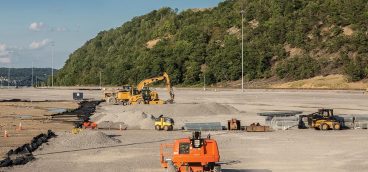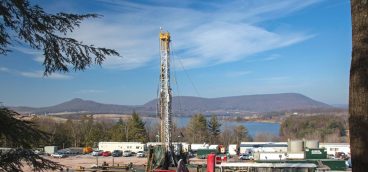Oxymoron or Opportunity?

From Pittsburgh to the hills of West Virginia, a small army of scientists is racing to tame the billions of tons of carbon vented from coal-burning power plants, working with data sets, computer models, cost analyses and other such tools that belie the drama of their high-stakes investigation.
Burning coal casts off nasty pollutants, including carbon dioxide, a notorious member of the heat-trapping greenhouse gases blamed for warming the planet to dangerous levels. Congress is on the brink of clamping down on CO2 emissions. The big questions are how and at what cost?
Coal-fired power plants today generate nearly half of the electricity Americans consume. That electricity is inexpensive. Our appetite for it is increasing. And there is nothing ready and waiting in the wings—wind, solar and other renewables included—to replace coal-produced electricity anytime soon.
For Greater Pittsburgh, there is more at stake. A large share of power plant coal is mined from seams snaking beneath southwestern Pennsylvania and its nearby neighbors. “If there were ways to burn it without producing carbon dioxide, we wouldn’t be sitting on coal,” says Andrew Gellman, head of Carnegie Mellon University’s Department of Engineering. “We’d be sitting on gold mines.” Although there’s no getting around the fact that burning coal makes CO2 and a host of air pollutants, there are ways to reduce its potential for environmental damage. And in recent years, southwestern Pennsylvania and West Virginia have emerged as a hub of scientific investigation into the technologies necessary to do that.
More than 100 university-based, government and industry scientists in the region are working on a broad portfolio of research projects to develop and refine technologies, from advanced turbines to coal gasification, that could extend the life of coal in a carbon-restricted world, buying time for alternatives to mature and assume a larger role in generating electricity.
And among the carbon management technologies under investigation, none has attracted more attention and support worldwide in recent years than carbon capture and sequestration, a method of reducing CO2 emissions that’s particularly well suited for large industrial facilities, such as power plants.
In fact, carbon capture and sequestration is on the short list of strategies widely considered essential to achieving significant CO2 reductions. That list also includes improving efficiency, expanding use of renewable energy and conservation. The top industry research organization, the Electric Power Research Institute— which adds building new nuclear power plants to the list of essential decarbonizing strategies—recently concluded that capture and sequestration of coal plant CO2 would be technically feasible by 2020.
The concept is simple enough: CO2 is separated from power-plant flue gas, converted to a fluid-like state, then pumped into underground porous rock, such as sandstone, where it stays trapped beneath formations of impermeable rock, such as shale. If it works without a hitch, as much as 90 percent of the CO2 emitted by a highly efficient power plant might some day be prevented from polluting the atmosphere. Adding to its appeal is the fact that commercial technologies for capturing CO2 from industrial gases have been used for years in natural gas treatment and the production of hydrogen, ammonia and ethanol.
But plenty of thorny technical, economic, regulatory and legal challenges still stand in the way of capture and sequestration becoming a viable option for reducing CO2 coming from power plants. The issues range anywhere from ensuring that highly toxic concentrations of CO2 injected into the ground stay put to determining who legally owns the tiny pores in the rocks into which the CO2 is injected. Nothing like carbon capture and sequestration has been tried on a large-scale commercial power plant. That has to be done—and successfully—before the power industry will seriously consider investing billions of dollars to install the new technology. Even then, it will require a powerful incentive to do so.
That incentive will likely be legal limits on CO2 emissions and penalties for violating them, an approach that’s been taken to reduce sulfur dioxide and other pollutants from industrial sources. “Carbon capture and sequestration won’t be used until CO2 is regulated,” says John Thompson, Coal Transition Program director for Clean Air Task Force, a Boston-based environmental nonprofit. “Nobody is rushing out to do it because there’s no carbon price driving it.”
The climate change bill narrowly passed in the U.S. House of Representatives earlier this year calls for a cap-and-trade approach to achieve a 17 percent reduction in greenhouse gases by 2020 and an 83 percent reduction by 2050. It also contains money to support early adopters of carbon capture and sequestration systems. But work on the Senate side was slowed by debate over health care reform, leaving the timing and specifics of greenhouse gas regulation unclear.
Such legislation is driven by concern over dire scientific forecasts of widespread damage to the environment and societies worldwide from increasing concentrations of greenhouse gases in the atmosphere. Because greenhouse gases such as methane and CO2 absorb and emit heat, an increase in their concentration in the atmosphere tends to have a warming effect on the planet. While measurements of some regulated air pollutants, such as nitrogen oxides, show concentrations have thinned in recent years, concentrations of greenhouse gases have been steadily increasing. In the case of CO2, concentrations have risen from 280 parts per million during pre-industrial times to a level of 382 parts per million recorded in 2006, according to the National Oceanic and Atmospheric Administration. The Environmental Protection Agency reports that a 20 percent increase in CO2 concentrations occurred between 1990 and 2004 alone.
The consensus of scientists who’ve studied climate change is that human activity deserves most of the blame for escalating levels of greenhouse gases. Although not without controversy, that conclusion—and the weight of climate change evidence reported by influential science panels such as the United Nations Intergovernmental Panel on Climate Change—have pushed curbing CO2 and other greenhouse gases up near the top of the to-do lists of lawmakers.
Whether any such law will lead to the use of carbon capture and sequestration in commercial power plants will depend on the specifics. Setting the carbon price too high or requiring steep CO2 reductions too soon could, for example, push the industry away from coal toward other mature options, such as nuclear or natural gas. But if the carbon price is set too low, industry would have little economic incentive to invest in the expensive new technology.
And few doubt that carbon capture and sequestration will be expensive, particularly during the early years. Estimates suggest that carbon capture and sequestration would increase the cost of generating electricity by 60–80 percent at coal-fired power plants and by 30–50 percent at coal gasification plants, of which there are only a handful in the world. “But until we actually do this on a big commercial power plant, we won’t know for sure what it will cost,” says Edward Rubin, alumni professor of environmental engineering and science at Carnegie Mellon, who shared the 2007 Nobel Prize as a lead author of the Intergovernmental Panel on Climate Change report on carbon capture and sequestration.
“Right now, if you ask me, the major barrier is money. Where to get the money to get the technology off the dime. Because to do this at a big power plant—to build and operate a system for five years to get that experience—we estimate it would cost close to $1 billion. There’s been talk about demonstrating this at full scale for the last three or four years and they’re still talking.”
The cost of carbon capture and sequestration is expected to drop significantly once the technology is developed and utilities are given incentives to reduce CO2 emissions. To finance the first wave of commercial start-ups, Rubin suggests a trust fund created from fees on fossil-fuel-generated electricity. This summer, legislation was introduced in the House calling for a $1 billion annual trust based on that concept.
Such steps are critical to the long-term future of coal, he says. “The only way I know today to seriously deal with coal emissions is with carbon capture and sequestration technology. It’s a make-or-break technology for coal in the sense that if you want to have a stable atmosphere and deal with climate change, the options are to continue to use coal for some period of time with capture and sequestration or coal goes away and you try to use a lot more of everything else.”
For some, abandoning carbon capture and sequestration and the whole notion of generating electricity with coal is the more prudent approach to addressing climate change. In a recent report, Greenpeace International, noting the uncertainties associated with carbon capture and sequestration, calls it a “scam,” arguing that money would be better spent finding ways to use energy more efficiently and to ramp up the development of renewable energy sources.
Other environmental organizations see it somewhat differently. “Coal use is one of the most devastating environmental activities around,” says the Clean Air Task Force’s Thompson. “But I’m not willing to bet the planet that coal is going to go away. If it’s that we can’t live with it and can’t live without it, then I think it’s important to be realistic and change the way we use coal.”
The fact is, abandoning coal-fired power plants would leave a huge gap in the industry’s capacity to meet rising demand. As a base-load power source, coal-fired plants offer the around-the-clock generating capacity counted on to provide as much electricity as needed, when it’s needed, while peak-load sources like wind and solar are intermittent energy producers.
“You can’t expect to replace a base-load power source with electricity from a peaking source,” says Tom Sarkus, senior manager and technical analyst at the National Energy Technology Laboratory (NETL) in South Park Township. “We need more wind. We need more solar. But it’s unrealistic to think that in the near- to mid-term those sources are going to pick up enough slack to replace base-load power sources. What we need is a good mix of sources.”
NETL research centers in South Park and Morgantown, W.Va., are members of the regional brain trust working to develop cleaner fossil fuels for a carbon-restrained future. Carnegie Mellon, the University of Pittsburgh and West Virginia University are other key players, both through their individual research and work done as part of a research consortium organized by the NETL and supported by $26 million in U.S. Department of Energy funding.
Few other regions can boast such a collection of talent focused on clean energy research. “It’s not the only hub in the world, but it’s certainly a pretty concentrated level of expertise and investment,” says Carnegie Mellon’s Gellman, consortium research director. The consortium itself includes about 180 faculty, graduate student and postdoctoral researchers working on more than 100 projects that span eight areas of investigation, including carbon management.
The region is also home to significant private sector research directed toward developing cleaner fossil fuel technologies, including a demonstration of storing CO2 in unmineable coal seams led by Canonsburg-based Consol Energy, one of the world’s leading coal producers.
With 4.5 billion tons of recoverable coal reserves and some 7,000 employees in its coal operations, it’s no surprise Consol is willing to spend $4.2 million on a CO2 sequestration project in addition to supporting the industry’s largest research and development lab. “If you’re a betting man, you’d have to say we’re going to have carbon management legislation at some point,” says Tom Hoffman, Consol vice president of communications. “That means our customers who use coal are going to be pressed to come up with solutions to their carbon emissions if they want to keep operating their plants. To the extent we can, as a fuel provider, also provide them with a way to deal with their emissions, that’s a plus for us as a company.”
In Marshall County, just across the Pennsylvania border in the West Virginia panhandle, Consol researchers, working with NETL and West Virginia University scientists, have drilled horizontal wells to the Upper Freeport coal seam into which they are injecting CO2. The project allows researchers to look at a couple of important issues.
One is the process of injecting CO2 to free methane trapped in the coal, much the way it has been used for years to squeeze oil from underground rock formations. For the power industry, the ability to recover methane or oil as a marketable byproduct could make the idea of investing in expensive carbon capture and sequestration technologies a bit more attractive.
“The reason this works in coal beds is that CO2 replaces methane at a 2:1 or 3:1 ratio,” says Doug Patchen, a geologist with West Virginia University, who is an expert in geological sequestration. “Every time you put a molecule of CO2 down there, it kicks off two or three molecules of methane. That’s the value-added aspect of this.”
Researchers are also investigating the behavior of the CO2 they are storing in the coal seam, as well as the accuracy of available techniques for monitoring it. “The critical part of getting this approach to carbon management accepted is that, when you put this stuff into the ground, is there an expectation that it’s going to stay where it is supposed to?” says Hoffman. “The answer is, yeah, we expect it to. But the only way you can prove it is to put it in the ground and monitor it for a period of time.”
In Texas, University of Pittsburgh geophysicist Bill Harbert, NETL scientists and others are exploiting one of the few large reservoirs of underground CO2 in the world to see if they can calibrate imaging technology widely used in oil and gas exploration to accurately detect and define CO2 concentrations nestled 1.3 miles below the earth’s surface.
Plates underneath heavy trucks vibrate on the surface of the SACROC oil field, sending ultrasonic waves down to 93 million tons of CO2 that had been injected over decades to free oil from cavities that otherwise would not have been tapped. Scientists listen to the reflected waves, process the data and construct images of the supercritical CO2, whose properties lie somewhere between those of a gas and those of a fluid.
“Every single drop of oil and every cubic foot or meter of gas we have was discovered with this sort of technology,” says Harbert. “In that respect, these technologies are very mature. But the focus has been completely on determining the presence of oil and gas because there’s been a tremendous financial incentive to do so. There’s been no economic incentive to look at CO2 and, in that respect, the technology is not very mature.”
So far, their experiments have proved successful. But more work is necessary to make sure the images are accurate, including comparing their data with a large CO2 deposit beneath the North Sea that others have defined using a different imaging technique.
For the moment, though, the carbon capture and sequestration experiment drawing the most attention is the one just getting under way in New Haven, W.Va., a town along a stretch of the Ohio River that’s thick with power plants known as “megawatt valley.” There, the technology’s biggest commercial test to date is taking place at the 1,300 megawatt Mountaineer power plant, one of 25 coal-fired plants owned by American Electric Power, the nation’s largest electricity producer.
A little less than 2 percent of Mountaineer’s flue gas is being diverted to a small chemical plant where a “chilled ammonia” process drives off the CO2, which is then compressed to a supercritical state and pumped into sandstone almost a mile and a half under the ground. Scientists will study the process over several years to assess the technological and economic feasibility of retrofitting an entire commercial power plant with the new technology.
“We’ve allowed ourselves operational flexibility to tune different parameters, temperatures, pressures and other things so we can determine the most economical conditions for running the system,” says Gary Spitznogle, the company’s manager of coal gasification and CO2 capture engineering. “It’s more expensive to build it that way, but it’s a necessary step in development.”
One costly problem is the technology’s voracious appetite for electricity. Estimates suggest that older coal-fired power plants might find conventional carbon capture and sequestration systems consuming as much as 40 percent of the electricity they produce. American Electric Power is hoping Mountaineer’s chilled ammonia approach, which uses less energy than conventional carbon-capture methods, and other efficiencies will lower the technology’s energy demand to less than 20 percent of the electricity the plant makes.
And for all of the technical issues the experiment may help clarify, it’s the outcomes related to cost that, says NETL’s Sarkus, “has a lot of us in the research community crossing our fingers and holding our breath.”





